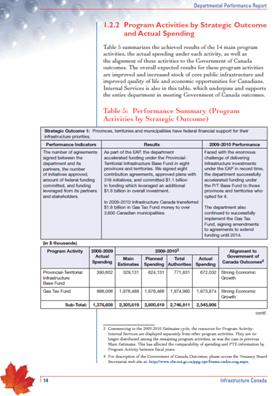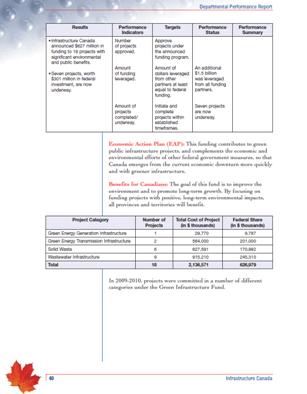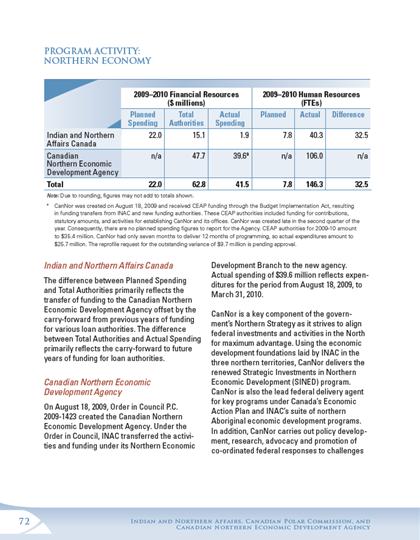Common menu bar links
Breadcrumb Trail
ARCHIVED - Performance Reporting: Good Practices Handbook 2011
 This page has been archived.
This page has been archived.
Archived Content
Information identified as archived on the Web is for reference, research or recordkeeping purposes. It has not been altered or updated after the date of archiving. Web pages that are archived on the Web are not subject to the Government of Canada Web Standards. As per the Communications Policy of the Government of Canada, you can request alternate formats on the "Contact Us" page.
Link resources to results
Planned and actual spending should be outlined in sufficient detail for readers to understand how the department performed financially. Notes to financial tables should be clear and understandable.
The relationship between planned and actual spending and expected and actual results should be explained in order to provide a full account of each program activity’s financial and non-financial resources that contributed to performance. Explanations could include, where appropriate, a discussion of actual results in relation to the actual expenses outlined in the department’s financial statements.
For each program activity in the RPP, it should be clear what the department intends to spend and what it intends to achieve over the next three years. In the DPR, it should be clear what the department spent for each program activity and what was achieved as a result of that spending, how actual spending compared with planned spending, and whether it represented value for money.
Human resources—planned and actual—should also be linked to results. An understanding of the workforce required to deliver programs and services to Canadians and to support the operations of government is essential.
Good practice: Link resources to results.
Why is the following a good practice? Throughout the DPR, the department discusses the extent to which expected results were achieved and at what cost. Tables help illustrate resource levels and the value of the actual results achieved. The discussion of the strategies employed provides an understanding of the nature of the expected results and the corresponding level of spending.
Good practice example: Infrastructure Canada DPR 2009–10


Discuss changes in resources
It is important to demonstrate that resources are being used efficiently and effectively and that expenditures correspond, in relevance and importance, to the outputs and short-term results achieved and the strategic outcomes being pursued.
Significant internal reallocations to meet emerging internal priorities or higher government priorities, or to better sustain progress toward the achievement of the strategic outcomes, should be discussed (i.e., amounts and areas affected, including the source of funds for the reallocation, the implications for human resources, and the identification of the program or initiative that received the funding). Appropriate references should also be made in the financial tables.
The report should discuss the impact of reallocation, expenditure review, or restraint exercises on the organization’s performance at the program activity level and their ability to contribute to the strategic outcome. Doing so will make the report more credible.
Good practice: Discuss changes in resources.
Why is the following a good practice? In this example, the DPR provides a detailed explanation of why and how resource changes took place and what programs and activities (pages 72 and 73) were responsible for carrying them out.
Good practice example: Indian and Northern Affairs Canada and Canadian Polar Commission DPR 2009-10

